In 2019, Matt Glover explained the visual effects work done by Mr. X (now MPC) on the first season of Carnival Row. He then worked on Jupiter’s Legacy and Nightbooks.
Back in 2020, Mitch Drain detailed the work made by Digital Domain on the first season of Perry Mason. He went on to work on Agents of S.H.I.E.L.D., Children of Corn, Chaos Walking and The Last of Us.
How did you get involved on the film?
Matt Glover // I was brought on board in June 2021, just as the show was being awarded to Mr. X/MPC. I was just wrapping up on Nightbooks for Netflix, and Mitch and his team were prepping the shoot, and finishing up some initial concept work to determine Chupa’s look/scale. We picked up the design work – quickly getting it into 3D with some initial concept sculpts and paintovers for Chupa and the fully grown version of the creature.
Mitch Drain // I was recommended to the producers at 26th St Pictures by Matt Butler, who had worked with them in the past.
How was the collaboration with Director Jonás Cuarón?
Matt Glover // It was great – all of our meetings and reviews were held directly with Jonás – so we were able to ask questions and get feedback in real time.
Mitch Drain // Jonás is extremely collaborative and afforded us a lot of creative space. We had many early discussions regarding the creatures and found agreement quickly. It was important to Jonás, and myself, that Chupa be grounded in reality as much as possible. Jonás had a wealth of great ideas, some easier to achieve than others but, I can say they all made our creature, and the film, better.
This is Cuarón’s first big VFX feature. How did you help him about that?
Matt Glover // It may be the first big VFX feature that he was directing himself – but he had a really firm grasp on visual effects – I’m sure co-writing a film like Gravity helps! He understood a lot of the terminology and methodologies, and had a good idea of what would and wouldn’t work to tell his story. He is also very keen to learn. When discussing a shot or sequence he would ask great questions on approach/workflow to build his knowledge base.
Mitch Drain // My approach to Jonás was the same as I have done with other directors. Whereas visual effects can often be misunderstood, Jonás did his homework and understands the principles of what we needed to do and how to achieve it. There really wasn’t much in the way of helping, other than to enlighten him on some of the complexities of shooting with visual effects in mind. Allowing time for HDRs, references and measurements, etc. In fact, there were times when he would ask if we needed more time and if we were able to get what we needed, which was very welcome and appreciated.
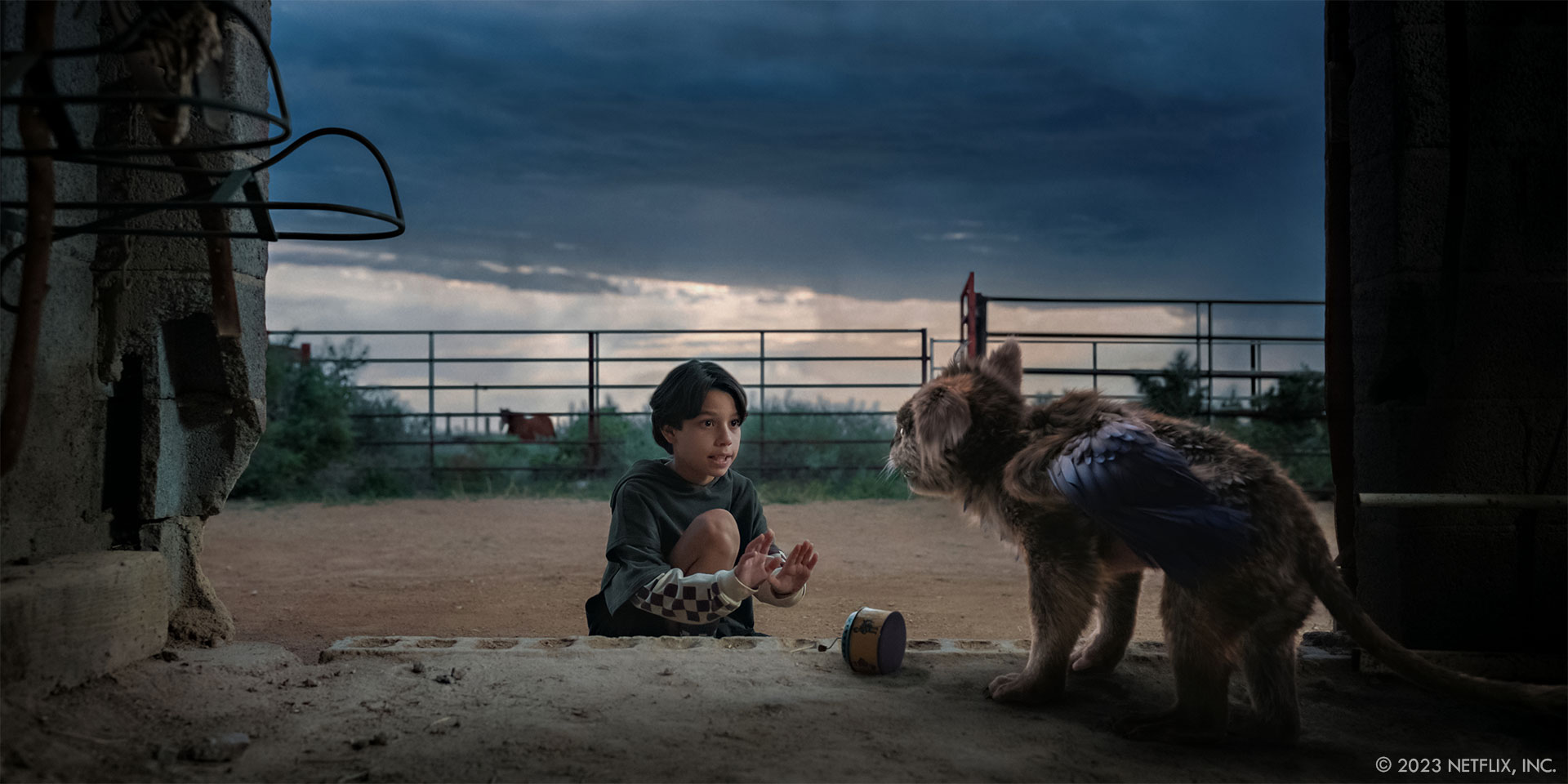
Can you elaborate about the design of Chupa?
Matt Glover // As everyone has noticed – Chupa is very cute. This was the biggest mandate – we wanted to design a creature who was mysterious, but also rooted in biology/evolution, tied into the mythology of the creature, but then turn it on it’s head – and instead of being a scaly or scary creature – go as cute as possible, while still maintain some realism.
Mitch Drain // Early on, there were discussions of Chupa being a little closer in appearance to the creature of legend. We felt we could create sympathy for Chupa through behavior and personality. Ultimately, it was decided that taking the expectation of a fearsome creature and turning that around would serve the story better. One idea that we all got behind was that Chupa needed to look as if he could plausibly exist in our world. We knew we wanted him to be cute but strove to avoid any design cliches for what a « cute » creature should be. We knew he had to be a land creature, but also needed to fly and have the sense of evolving into that creature. One consideration that took a bit of brainpower was that we also see the full-grown family of Chupa. As an adult these animals were to be intimidating and powerful, definitely something you would not want to cross, while still having a visual connection to our pup.
What kind of references and influences did you receive for Chupa?
Matt Glover // When I joined there were already several concepts that had been developed and revised, so we started from these. Then we looked at a lot of animal references for the different aspects of his physiology – bird/insect wings for iridescence, dogs/foxes for fur and patterning, koalas for eyes, big cats for the underbite/fangs, etc.
Mitch Drain // There were some early concept illustrations that helped set the tone of the feelings that Chupa should evoke in the viewer. We did not want Chupa to represent any single species of animal. Not necessarily feline, not necessarily canine etc. We looked at dogs, cats, koala bears, grizzly bears, wolverines and most quadrupedal animal pups, as well as eagles and parrots for wing construction.
Can you explain in detail about his creation?
Matt Glover // Once we received the concept work and some of the scale references – our first task was to quickly get a 3D sculpt going, so that we could start looking at him from different angles. We did some quick sculpts in a few key poses that Jonás was particularly interested in, as it would affect some of the blocking of the scenes, for example – How does Chupa hold objects? Can he sit upright on his hind legs? How do the wings look when they are open vs. folded up and tucked away? We did some more scale tests using the character’s heights to find a sweet spot for how big Chupa would be, and then these key poses help determine a lot of the other details, such as how skinny is he, how long is his tail, how big is his head, his eyes? Everyone was worried if we designed him in a bit of a vacuum we could run into issues once we started blocking scenes on set or later in animation. This way Mitch and Jonás could confidently frame and block shots on the day. Once we had his basic dimensions and color pallet down, a scale stuffy version was made, for lighting and framing reference on set.
Mitch Drain // We began with many concept drawings. Some played off the descriptions of the legend, others referenced the cuter side of nature. An early concept had a koala-like quality that helped set the tone for the final design. From there, dozens of sketches from different artists showing body poses and expressions were created. Many were cartoony, or looked great for an animated film but needed grounding in reality. Once our VFX vendor Mr. X (now MPC) got involved, we worked with concept artist Nikita Lebedev to create a full 3D concept based on an amalgam of the best ideas, which ultimately evolved into our creatures. It was important that Chupa be cute, yet still be a wild animal that could become fierce when provoked. Having the zBrush model allowed us to sculpt the various poses and expressions to satisfy Jonás and the producers that we could achieve all of the required emotions and action. Chupa’s size was an area of evolution and discussion. To grow into a bear-sized adult, Chupa needed to be around the size of a 25lb dog. We discovered that under certain lensing and compositional settings he looked too big in relation to the kids. The team at Mr. X worked out a system by which we could reduce Chupa’s screen size by about 10% without affecting the rig to address that issue. There are many subtleties to Chupa that are not readily apparent yet subliminally improve the performances. For example, Chupa has retractable claws that give a clue as to Chupa’s level of stress or anger. Another is that Chupa’s fur can stand on end when he is threatened. We see some of this when Quinn corners Chupa in the barn. We found that we needed to be careful with this effect since it made Chupa appear larger and rounder. Chupa’s mouth interior is uniquely designed using elements from birds and other mammals to give a visual representation that explains the distinctive singing howl of the character. It is rarely seen but shows the level of detail Jonás wanted for our creatures. I could go on for days about the sheen of the wing feathers, the reflectivity of the eyes and wind shear through fur and feathers. Suffice to say that there are many subtleties in the granular detail of making Chupa feel alive that also had to be migrated to the three adult Chupas.
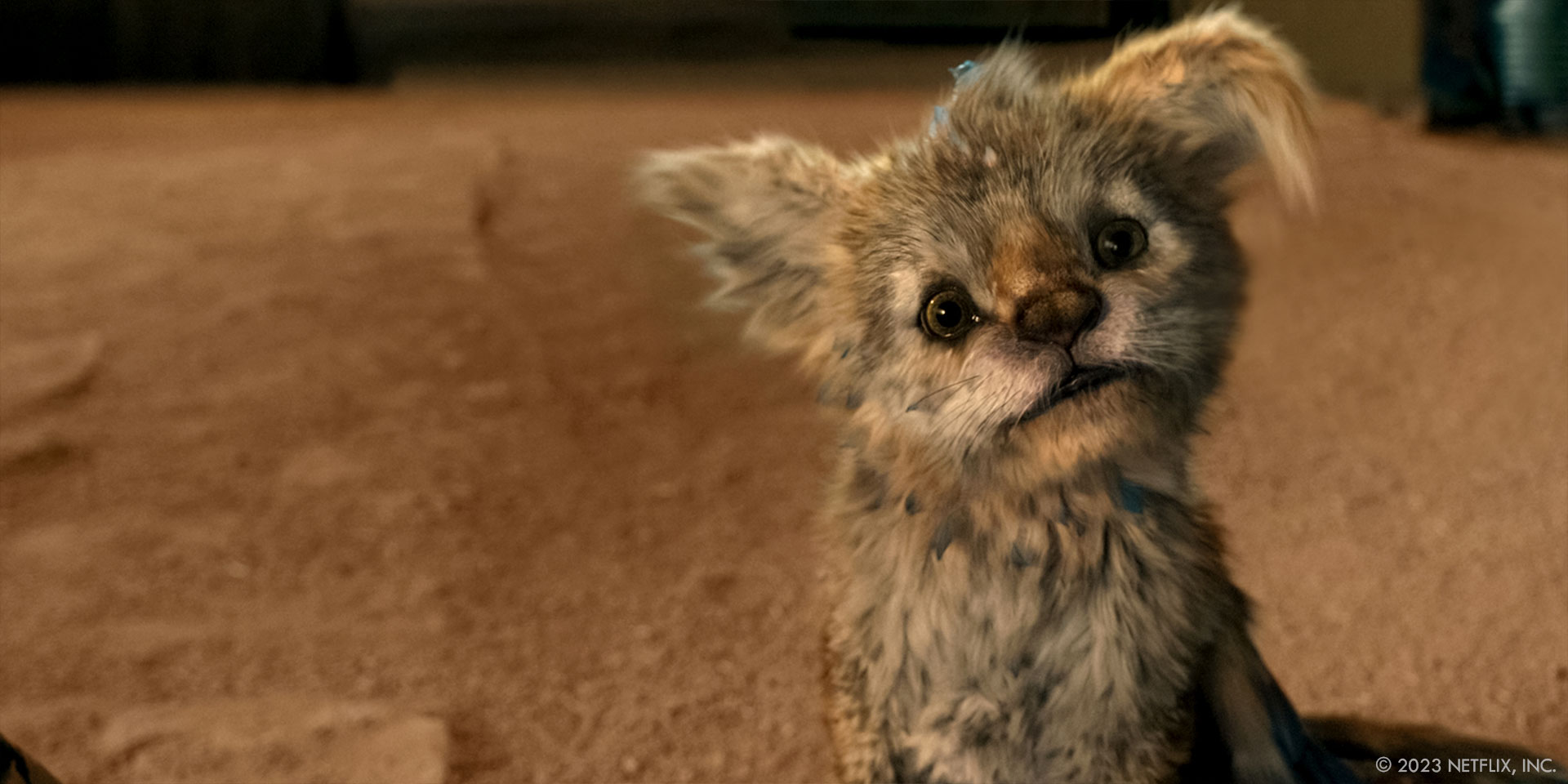
How did you help the actors and especially Evan Whitten to simulate his presence on set?
Matt Glover // Harper the dog! The production cast an amazingly talented dog named Harper to stand in for Chupa. He was just a little smaller than Chupa was going to be, to help with paintouts, but Evan was able to really act with the dog – adding a lot of emotional weight to the scenes that we would use as our jumping off point once we started animating Chupa. For scenes where using Harper wasn’t possible, like a complicated entrance or exit, or for a long extended shot, there was also an articulated gray stand-in puppet that could be posed for Evan to interact with. Also good old fashion tennis balls on sticks, or tracking markers to help with eyelines.
Mitch Drain // Whenever possible we had Harper, an expertly trained dog slightly smaller than the size and mass of Chupa, for Evan, and the other actors to interact with. Jonás had observed subtleties in the way his children interact with the family dog, and Jonás wanted that real sense of connection with a living creature to interact with. For scenes where it was impractical to have Harper perform, we had a full maquette and a « stunt » Chupa for eyelines. In instances when a very specific, repeatable performance was needed it was a combination of good direction, acting and an amazing tennis ball performance manipulated by yours truly!
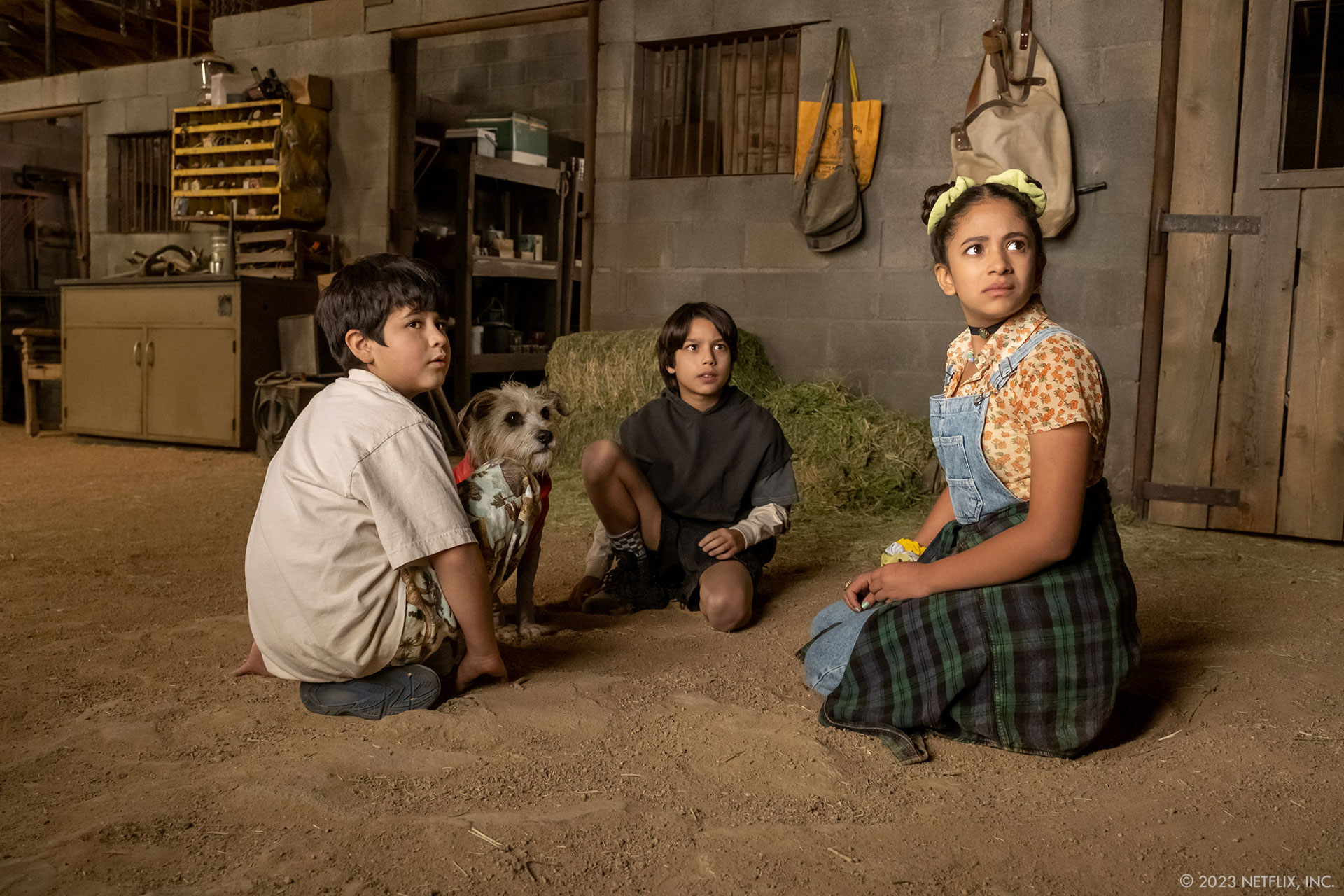
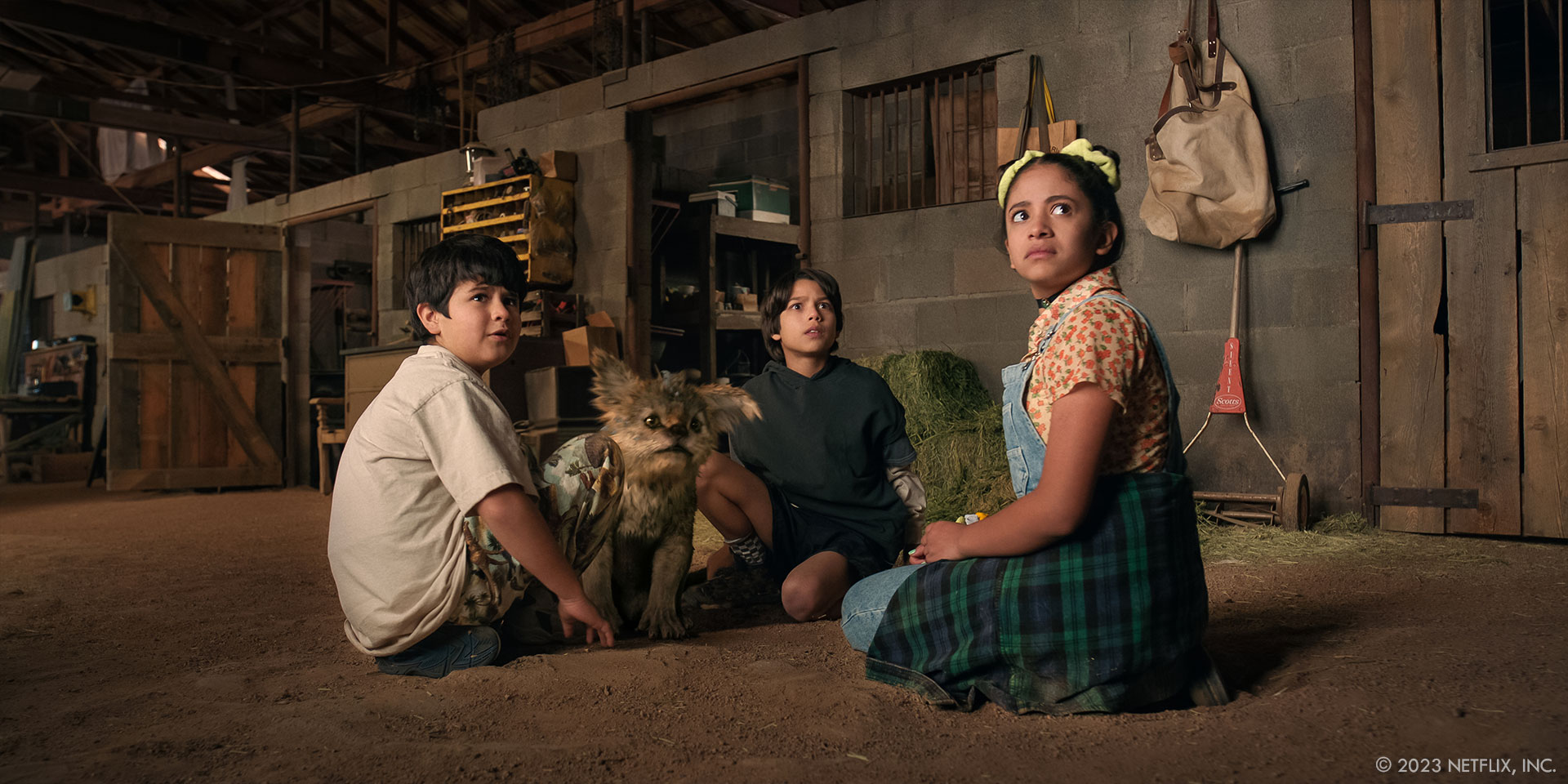
Chupa is very expressive. Can you tell us more about the eyes work and face animation?
Matt Glover // His eyes are definitely the feature we revised the most early on – everyone understood that the eyes would really dictate the cuteness, but also would make or break the performance. We did a number of mockups and lineups for the eyes. Scaling them up and down. We did this at each point of the design cycle – to make sure it was really working. When we were sculpting his face and head before adding fur, we would do wedges for the eyes, and then once we moved onto the groom phase we did the same, to make sure his features were staying in balance. Animation wise, Art Curry at our Adelaide studio was our Animation Director and he oversaw the animation tests, blend shapes and rigging as it was being done, while also working directly with Jonás to make sure the finished asset was going to be able to give the performance he needed to tell the story.
Mitch Drain // I’m glad that came across. We spent a lot of time getting that right. This goes back to the concept of a creature that could possibly exist in our reality. We all understood that the eyes would be key to communicating emotion. The eyes were an evolving element as we were trying to keep Chupa believable. Too small looked a bit ratty, too large was too cartoonish. We created multiple wedges for presentation before the proper size was agreed upon. It was very important to Jonás that the eyes be very reflective as they are the focus of the viewer. We developed a system by which we would light the eyes independent from the rest of the character to subliminally heighten the emotional connection to Chupa. It is a good example of when absolute fidelity to the practical environment may get in the way of beautiful imagery and enhancing the story. We had to be careful to find a balance with the eye lights to the environment, so that the lighting felt cohesive, and I think we achieved that. Most animals have limited facial movements and emotion is expressed through body language and very subtle facial movements. We agreed that dogs have the most readable and emotive faces of the animals we were referencing. With that in mind, we used the eyebrows, subtle eye movements and nostril flares, as well as the time tested head turn to express emotions.
How did you handle his fur and his feathers?
Matt Glover // Besides the eyes, his fur and wing feathers were the other design aspects we worked on the most – the groom was very detailed and underwent a few revisions even once we started getting Chupa into shots. As we animated and saw him rendered, we started revising/optimizing the fur groom both technically and creatively. Colour, pattern, contrast – we did a few rounds tweaking these variables as we worked to help him integrate into the environments – we also revised the length of some fur, the messiness/asymmetry/break up and the location of the blue feathers throughout his body. His fur was simulated on top of a muscle simulation, and based on the shot we also had either a wind simulation, or character interaction, like a rotoanim of Alex’s hand that we would sim against. The wings were also a pretty big challenge, to have them folded up against his body, tucked into the fur. The feathers were also simulated, and in shots where Chupa’s were flying we had a dynamic sim across the winds to add air resistance and buffeting.
Mitch Drain // Fur and feathers are understood to be among some of the most challenging textures to achieve. These elements were constantly evolving and improving as shots were refined. From a design standpoint, the fur needed to have a naturally organized pattern, while feeling individual to our creature. It was also very important that Chupa not look too « groomed ». He and the adult Chupas needed to feel as if they exist in the wild, with randomly clumped fur, random dirt patterns and a behavior that reflects the conditions of the environment. We prepared dozens of options for presentation and once we landed on an appealing fur pattern, we addressed the challenge of integrating feathers. The feathers for the wings were easier to design in that we knew we wanted an impressive wingspan for both the pup and the adults. The wings of the American Eagle have those qualities however they are mostly black and brown in color. Macaws have brilliantly colored feathers and crows have an iridescence that, together, created a unique but believable texture for the wings. Getting light to play across these surfaces was not always natural within the lighting, so we designed a pass for compositing to help dial in the prismatic effect on the feathers to taste.
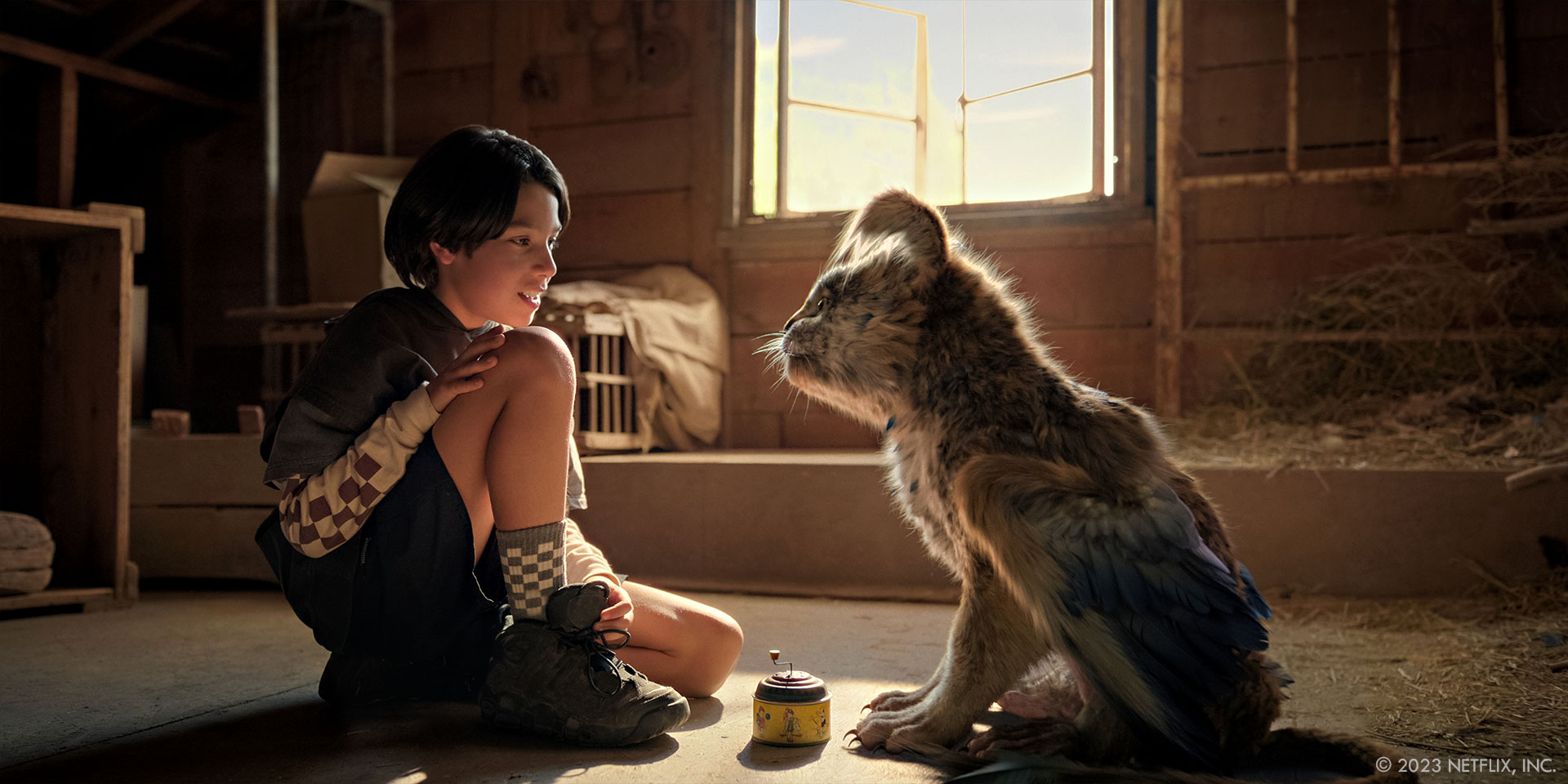
Can you elaborate about the animation work?
Matt Glover // Besides the actual build of Chupa, Animation took most of our schedule – we had over 300 hero shots of Chupa – we were adding the namesake character to the film. Art Curry oversaw all of the stages of animation, beginning with key poses, rigging and blendshapes. We did walk cycles to nail down Chupa’s walk and run, his trademark flopped over ear. We did anim tests on the eyes and face to determine the range of expression. The film was heavily post-vized, so as sequences turned over we would have a detailed call with Art and Jonás and Mitch – but Jonás was very encouraging to have us add beats or try different things as well.
Mitch Drain // I must give props to Animation Supervisor Art Curry and his team at Mr. X. He understood the need for reality based performances. As noted earlier, facial animation needed to be expressive yet realistic. We relied mostly on the eyes and head movement to sell those moments and worked to avoid any over-the-top, cartoonish expressions. We asked for a lot of physicality and emotion from these creatures. Some concessions had to be made for the physics of a creature to fly, so we incorporated the feeling of effort into the flying animations. Our Chupas are primarily land creatures who can fly when necessary. The « Papa » Chupa has an injured wing that was important to communicate to the audience, and the pup is learning those skills. I also don’t want to leave out the mountain lion that required very natural movement. Everybody knows how a large cat should move. For one specific shot we found a clip of a mountain lion menacing a person who got too close. The fast, slapping motion is not something seen very often and that motion was perfect to help sell the danger that our characters are in, and the animation team did a stellar job of it. I also want to thank our previous vendors, Proof, who brought so much to the process. They went above and beyond to not only set-up shots and determine pacing etc., but also went the extra mile to help Jonás hone in on performance aspects of the Chupas.
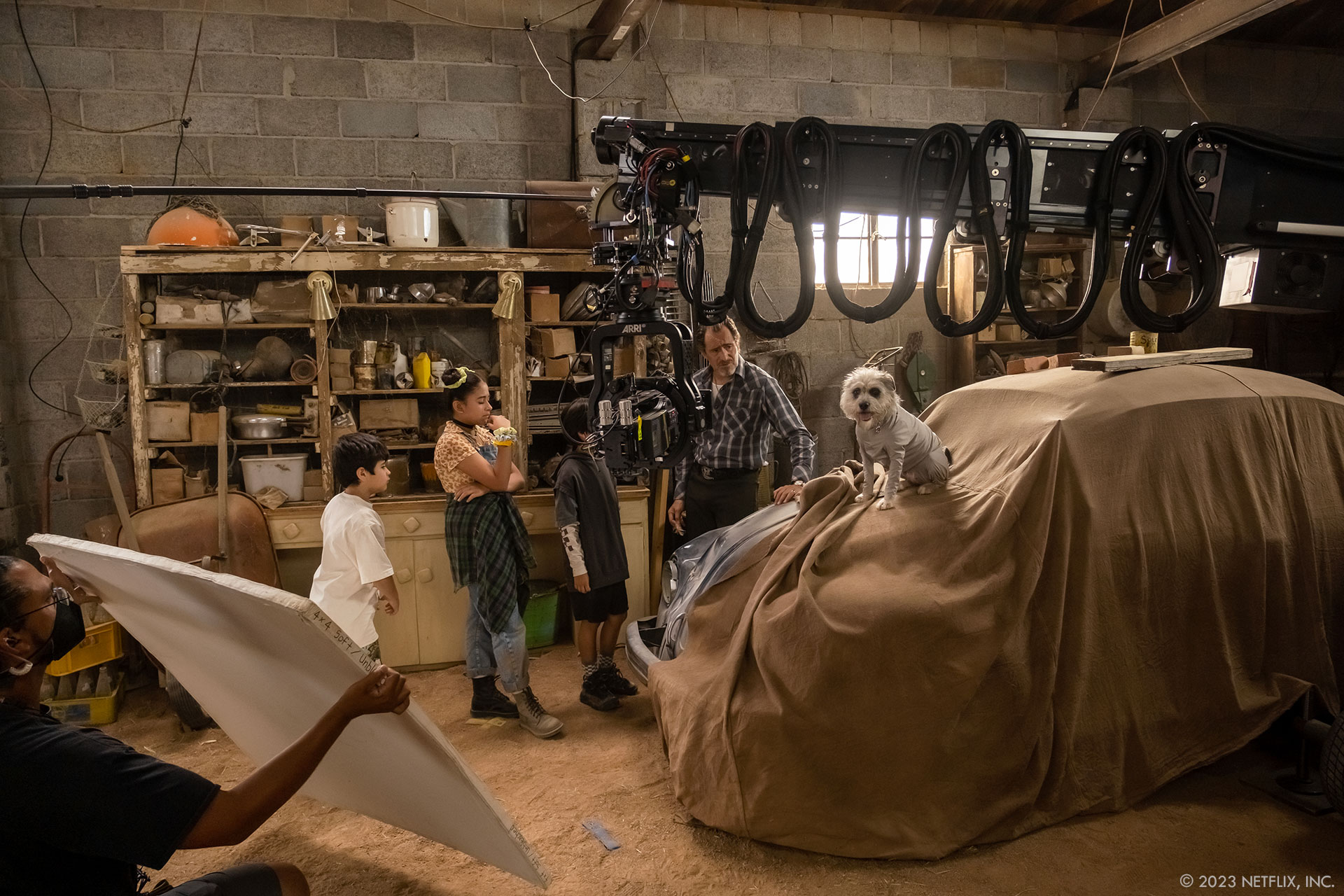
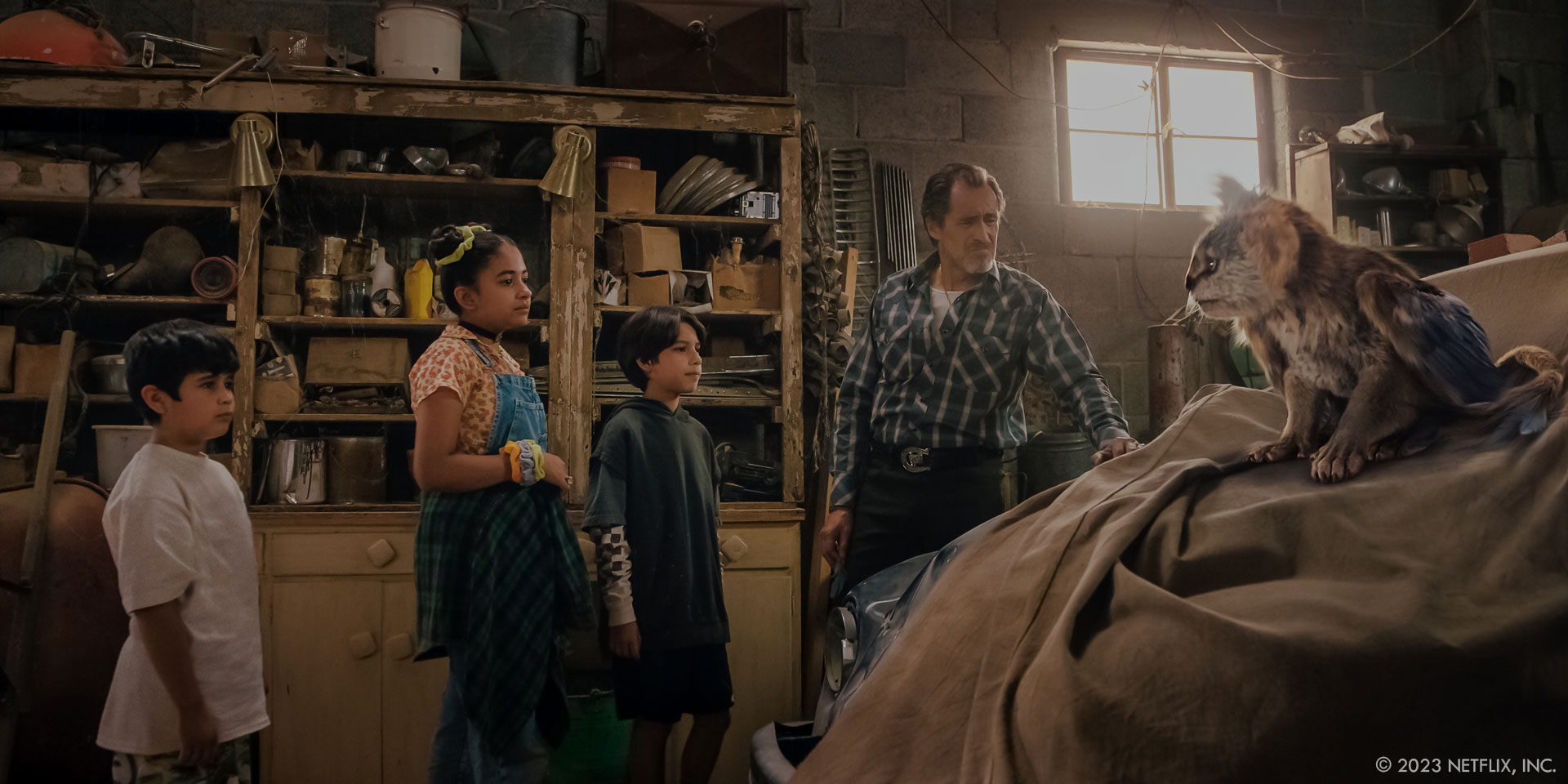
What was the main challenge with Chupa?
Matt Glover // The volume of shots, and the length of some of them as well. A few of the shots ranged almost 2 full minutes, with multiple animated characters in frame the entire time and the average shot length was almost 8 seconds. It was a lot to animate and sim and render. The interactions between the characters and Chupa were tricky as well, as Harper the dog had a slightly different silhouette, so we had to really revise some of the rotoanim and hero anim to work together.
Mitch Drain // It all goes back to believability. In design, animation, rendering and compositing. Can we convince the audience that these creatures could exist? While this is the eternal goal for VFX, with CHUPA, we needed to tell a heartfelt story that would be unencumbered by the realization that VFX are being used. We hope to make the viewer forget the fantasy and embrace the story. This is something the director, writers and producers all stressed early on. If we weren’t believing it, the audience wouldn’t either. From the perspective of filmmaking, the level of interaction that the characters have with our CG creature, as well as environmental interaction, created the most challenges. As Chupa moves through an environment, we wanted him to be firmly planted in that space. Little things like bumping a table leg, or the displacement of objects as he shifts his weight are important to the believability. We worked very closely with the special effects department to puppeteer and time these interactions. There was very little retiming necessary to integrate animations which is a testament to the value of rehearsal and planning ahead. As far as interaction with the actors, we tried to be as efficient as possible. Jonás was very aware of the difficulties that complex interactions could cause and we strove to avoid those problems as much as possible; however, we did not want to limit the actors’ natural reactions. Dealing with direct contact to Chupa presented issues with fur interaction that was handled on a shot-by-shot basis. Some shots required matchmoving hands and complex fx simulations while others relied on brute force 2D compositing solutions or combinations of both.
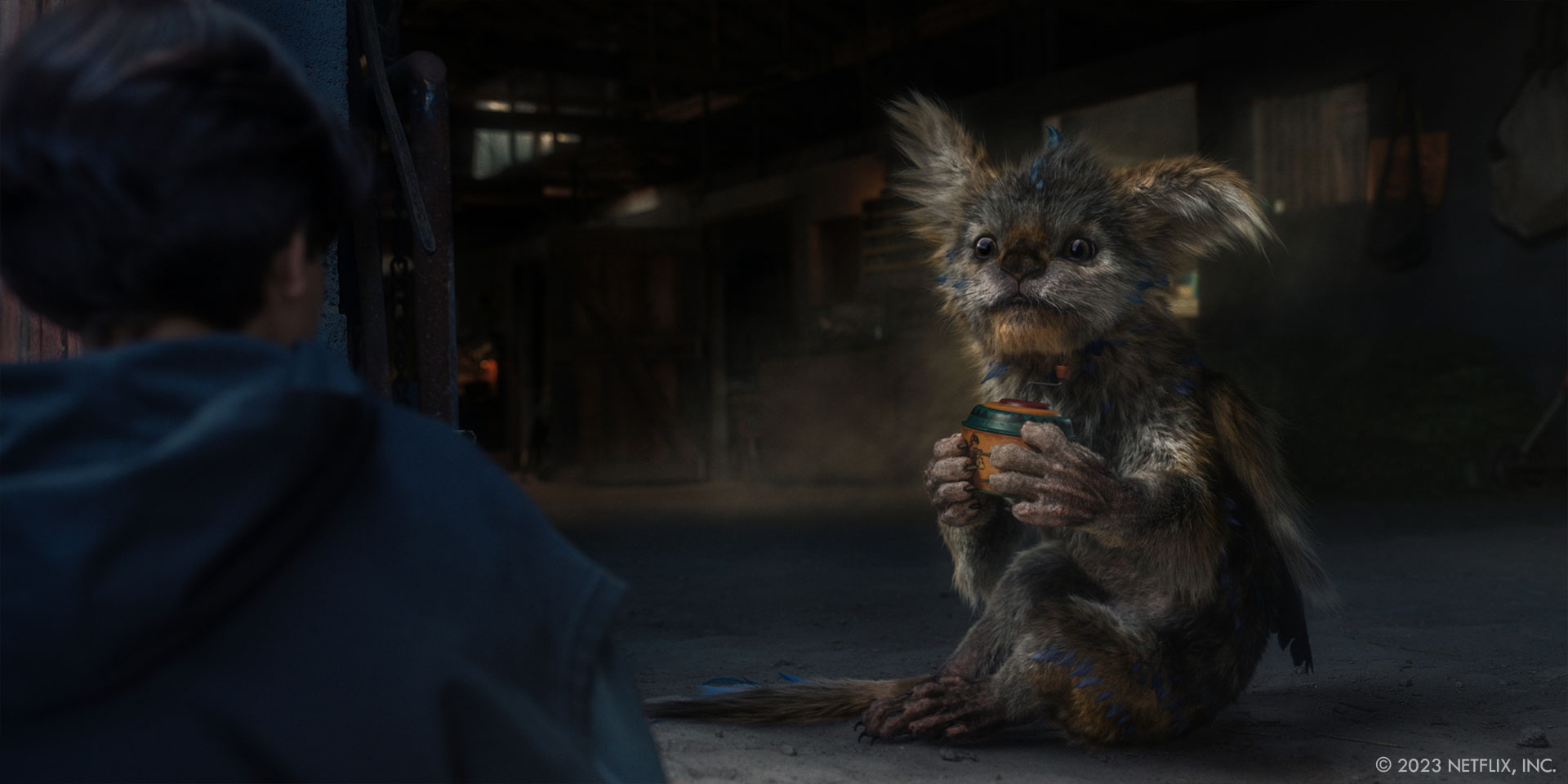
Which shot or sequence was the most complicated to achieve?
Matt Glover // The sequence near the end of the film, where the 3 adult Chupas are attacking Quinn’s SUV – as we often had CG Chupa, 3 other CG creatures and a CG SUV that was being progressively damaged, as well as CG dust simulations as well.
Mitch Drain // That’s a difficult question because there are so many challenging shots in the movie. We had one shot that was over a solid minute of Chupa and his father having a complex and emotional moment. I would have to say though, that the action sequence of Alex and Chupa on the pipeline over a canyon was probably the most complicated due to the scope and number of shots. Every discipline of visual effects came to bear as Alex and Chupa have an emotional parting while at the edge of a 100 foot deep canyon. Alex is attacked by a mountain lion and Chupa comes to the rescue. Not only did we have complex facial animation, we had extremely physical action that pushed our character rigs to their limits. In addition, we have the mountain lion attack that needed to be believable and frightening. Finally, on top of these complexities, we had an extensive set extension that included the canyon, decaying pipeline with destruction animation, bushes and desert extensions, sky matching and extremely difficult rig and crew equipment removals. In fact, I think this may have been one of the most challenging of my career due to the massive amount of work and the importance to the story.
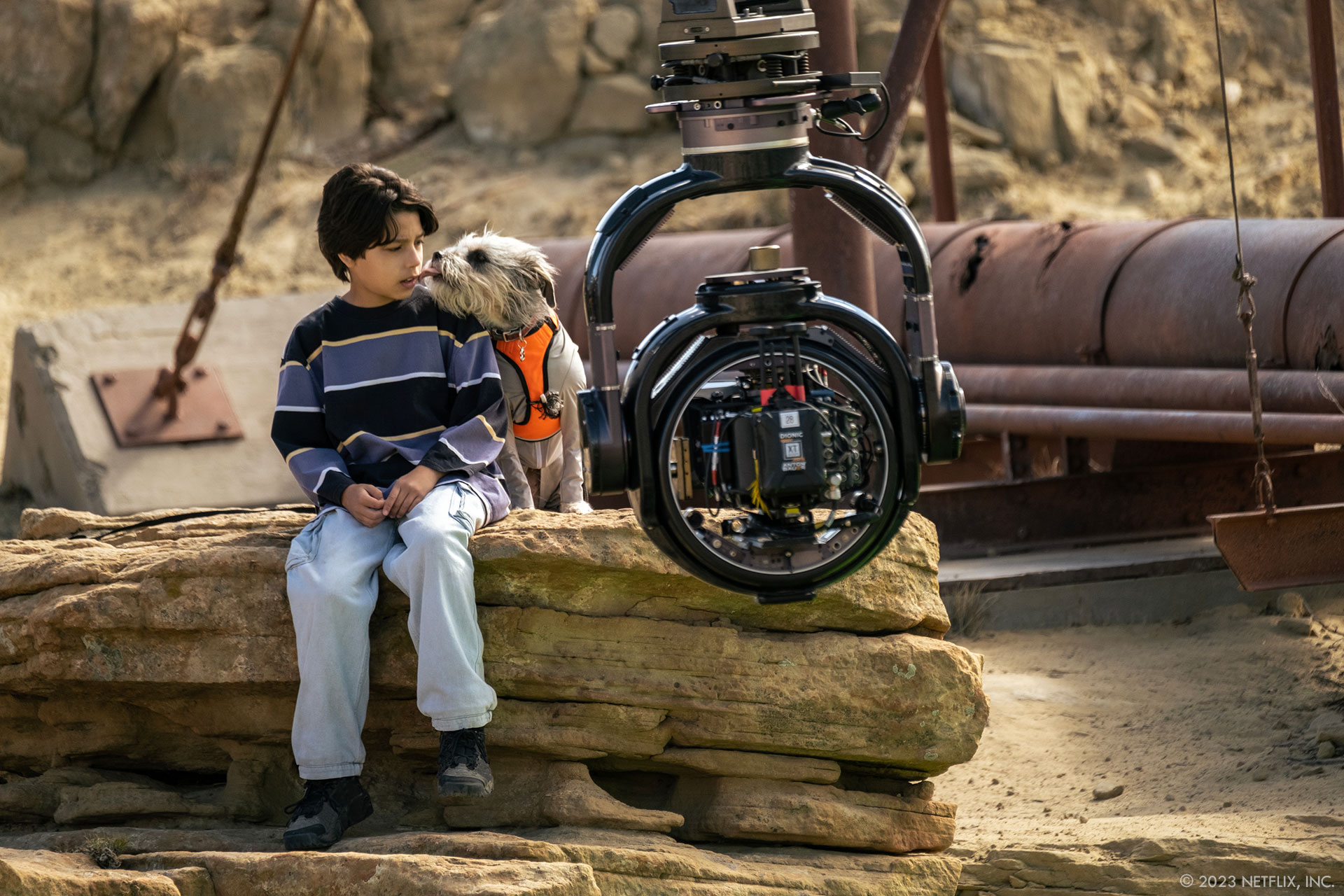
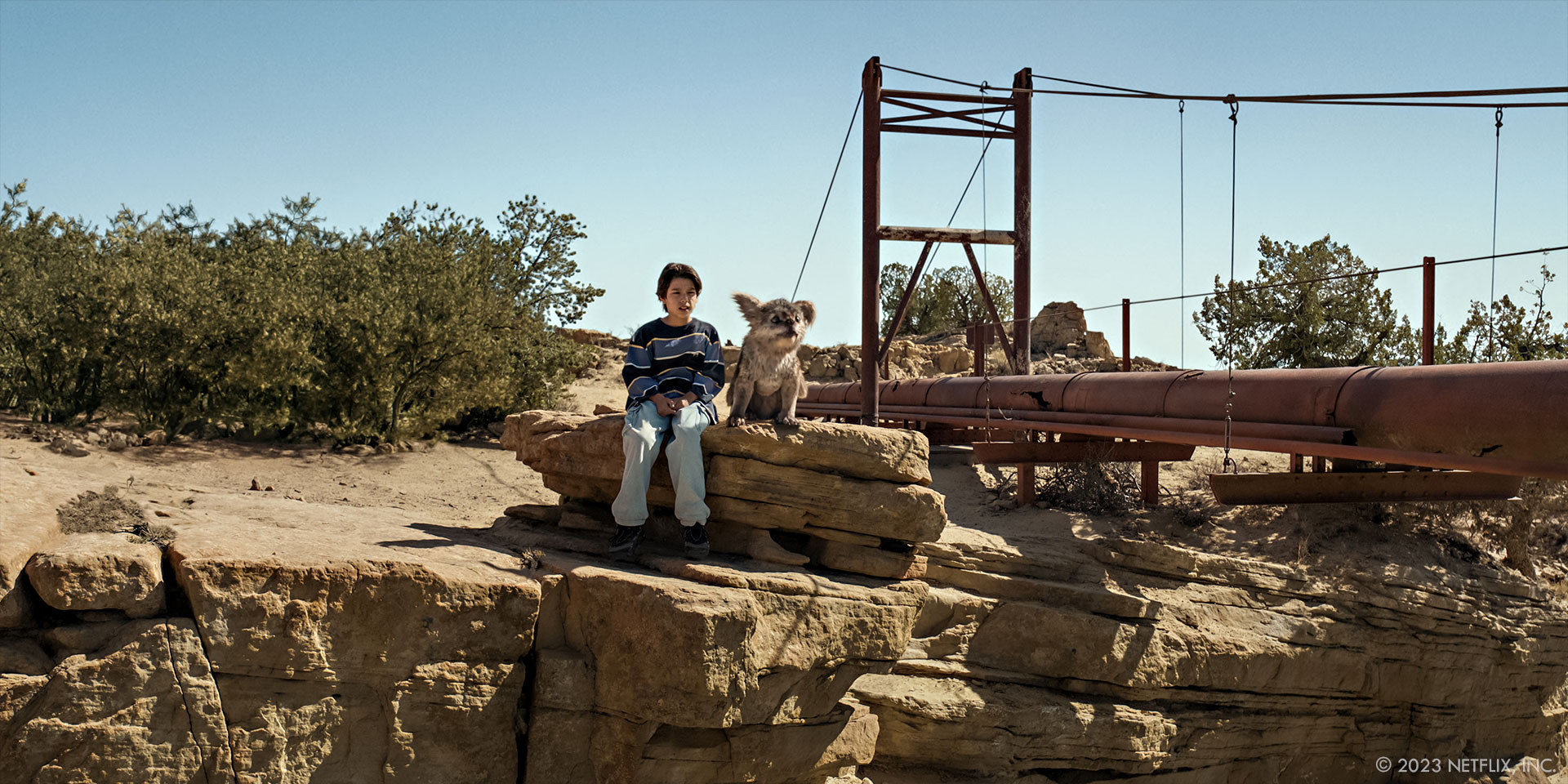
What is your favorite shot or sequence?
Matt Glover // I think the sequence in the barn where Chupa and Alex meet for the first time, and then all the kids meet him. The animation was the most nuanced, starting off small and reserved, then getting to show off Chupa’s playful side, across a few different lighting scenarios. We get a really good look at Chupa here, some of the best close-ups in the film. Or, the big pipeline set piece, which has some of the most complicated shots. We sometimes had a CG Mountain Lion, CG Chupa, and Alex clinging to falling CG pipes over a big CG set extension for the canyon.
Mitch Drain // I am very proud of the canyon sequence, and all of the work in general. I think the first meeting of Alex and Chupa in the barn is beautiful to look at and showcases some very fine animation as well as integration of a CG character in an environment, interacting and sharing the screen with a principal actor while not drawing too much attention to the VFX-iness (is that a word?) of it all.
What is your best memory on the film?
Matt Glover // I got to travel from Toronto to New Mexico to film some additional scenes of Chupa and was able to work with the cast and crew in person, and stage some of my favorite shots in the film.
Mitch Drain // The shoot itself. I feel that the VFX team, in cooperation with the art department, director of photography Nico Aguilar, special effects, stunts and of course the director Jonás, found a mutual understanding and respect for the process. The story and requirements of the visual effects were constantly evolving, which made for difficult problem solving that required quick thinking and the production teams all working together towards the best result.
A big thanks for your time.
WANT TO KNOW MORE?
MPC: Dedicated page about Chupa on MPC website.
Netflix: You can watch Chupa on Netflix now.
© Vincent Frei – The Art of VFX – 2023






